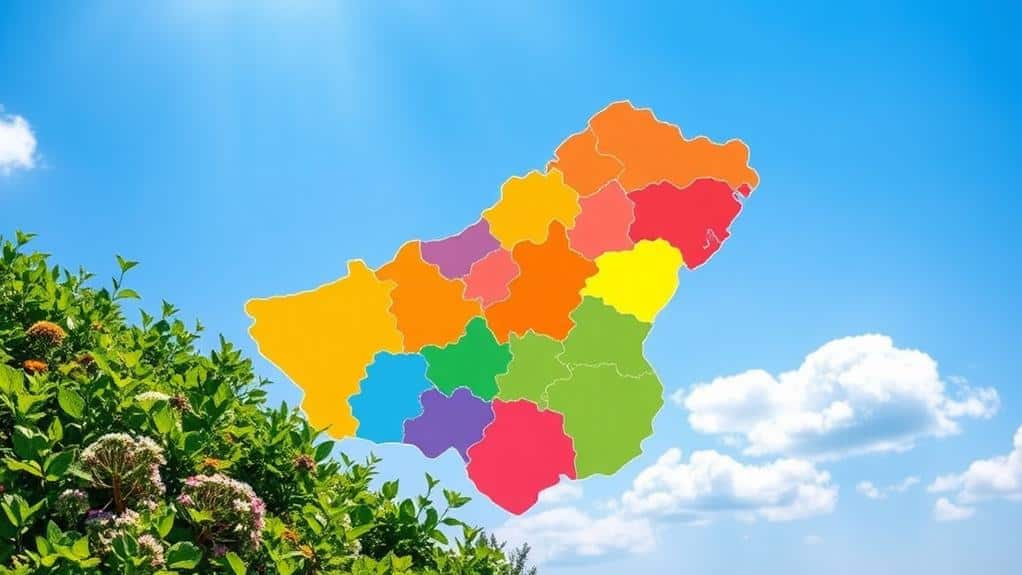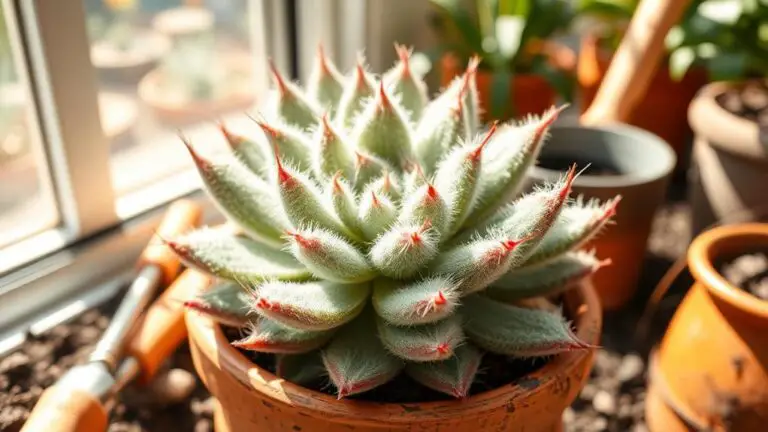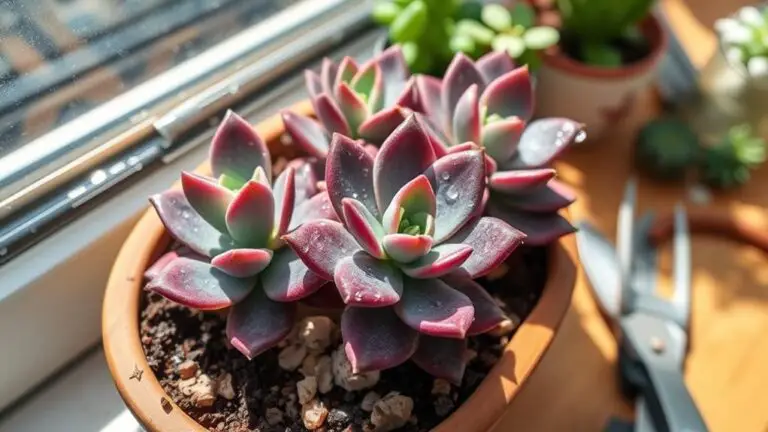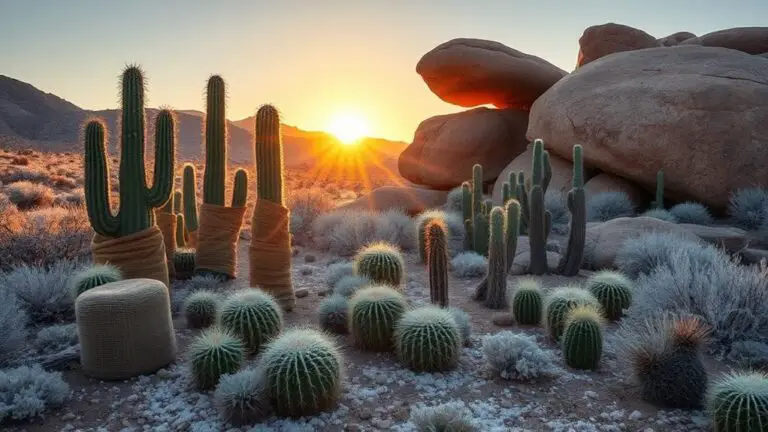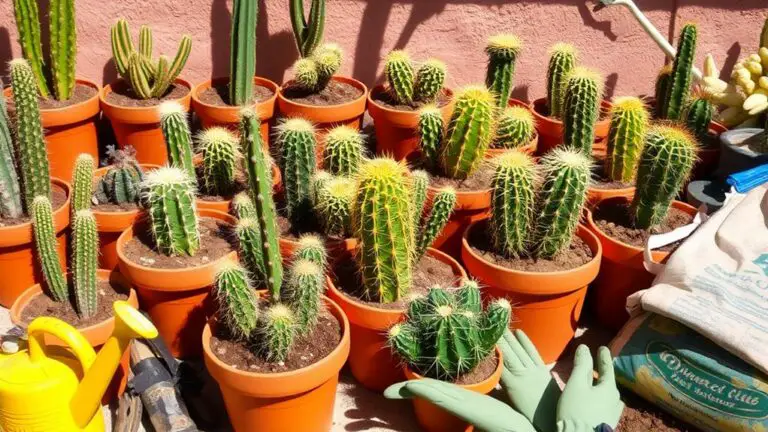What Growing Zone Do I Live In?
Have you ever wondered why some plants thrive in your garden while others struggle? Understanding your USDA hardiness zone can be a game-changer. By knowing your specific growing zone, you'll be able to select plants that are well-suited to your local climate, leading to a more successful and enjoyable gardening experience. But how exactly do you find out which zone you live in, and what factors should you consider beyond just the USDA map? Let's explore this essential information and uncover some surprising details that might influence your gardening decisions.
Understanding USDA Hardiness Zones
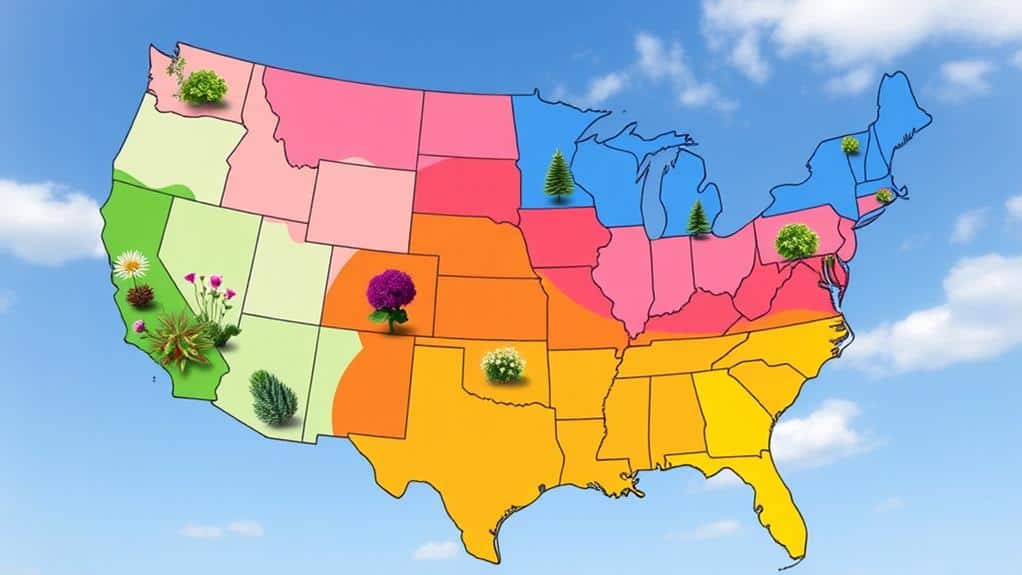
Understanding USDA Hardiness Zones is essential for any gardener aiming for a thriving garden. These zones, defined by the U.S. Department of Agriculture, are based on the average annual extreme minimum winter temperatures. By knowing your USDA hardiness zone, you can determine which plants will thrive in your region, ensuring a successful and beautiful garden.
The USDA Plant Hardiness Zone Map divides the United States into 11 distinct areas. Each zone represents a 10-degree Fahrenheit difference in average minimum temperatures, ranging from a chilly -60°F in Zone 1 to a balmy 70°F in Zone 13.
But it doesn't stop there; each zone is further split into subzones, labeled 'a' and 'b'. These subzones help you make even more precise plant selections based on slight variations in your local climate.
Originally developed in 1960 and updated several times since, the USDA Plant Hardiness Zone Map is an important tool for gardeners. It guides you in choosing plants that will adapt well to your local conditions and avoid planting species that mightn't survive your winter temperatures.
Knowing your local USDA hardiness zone is a key step toward creating a healthy and thriving garden.
How Zones Are Determined
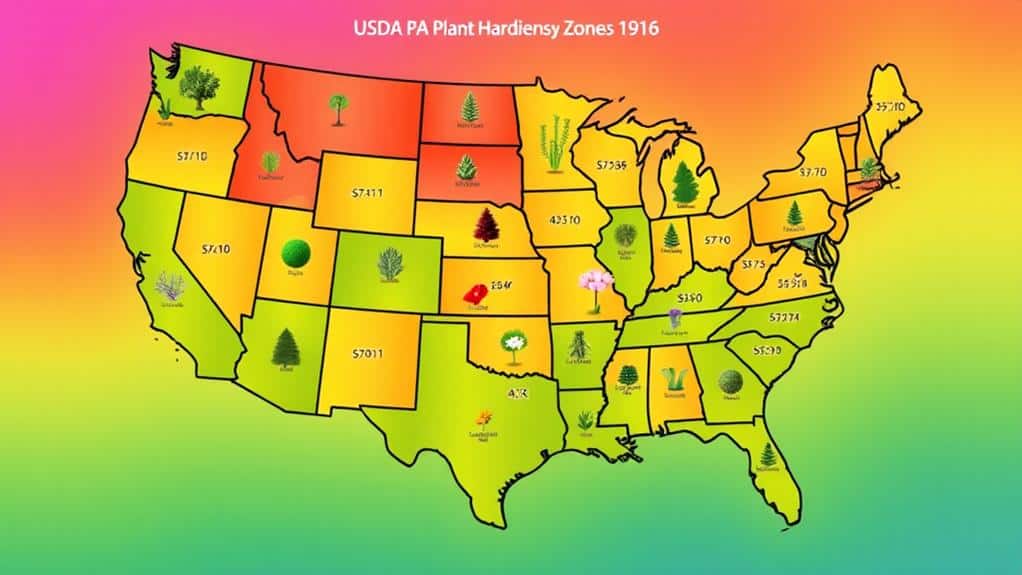
To grasp how USDA hardiness zones are determined, it's important to focus on the key factor: average annual extreme minimum winter temperatures. These temperatures indicate the coldest conditions that a plant can withstand. The USDA Plant Hardiness Zone Map divides North America into 11 distinct zones, each representing a 10-degree Fahrenheit difference in average minimum temperatures. This helps you identify your growing zone easily.
Each zone is further subdivided into "a" and "b" categories, providing more precise climate data. For instance, Zone 5a is slightly colder than Zone 5b. The coldest zone, Zone 1, experiences temperatures between -50 to -60°F, while the warmest, Zone 13, has lows of 60 to 70°F. This detailed breakdown guarantees you can choose plants that will thrive in your specific area.
Here's a quick reference table to illustrate:
| Zone | Temperature Range (°F) |
|---|---|
| 1 | -50 to -60 |
| 5a | -20 to -15 |
| 5b | -15 to -10 |
| 10a | 30 to 35 |
| 13 | 60 to 70 |
The zones are updated periodically, with the latest USDA map revision occurring in 2023. This keeps the data accurate, helping you select appropriate plants for your specific climatic conditions.
Using the Zone Map
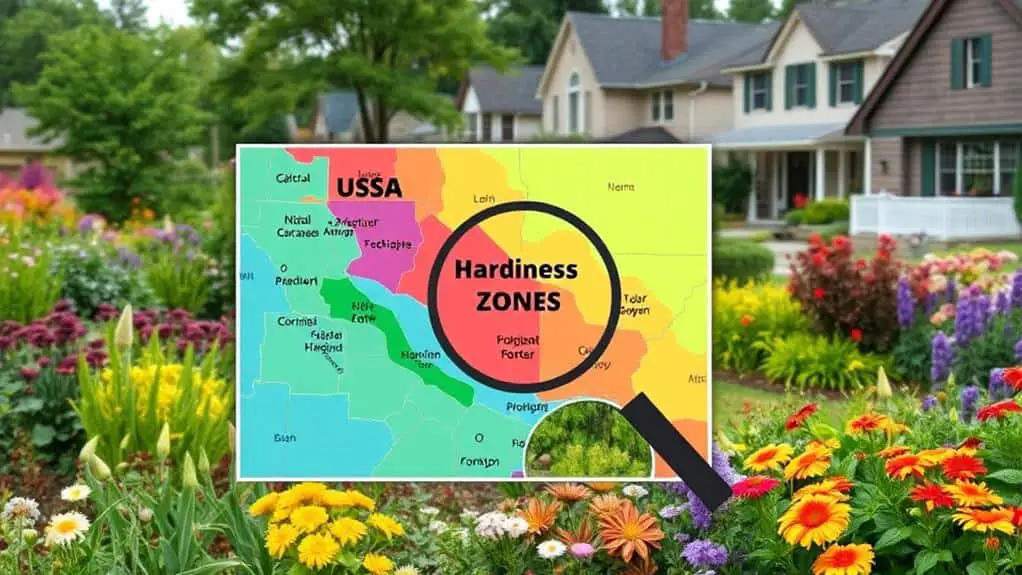
When using the USDA Plant Hardiness Zone Map, you'll find it helpful to explore the interactive features that make identifying your zone easy.
Just enter your zip code into the Quick Zip Code Search tool, and it will instantly show your specific growing zone.
This updated 2023 map includes precise data, so you can confidently choose plants suited to your local climate.
Interactive Map Features
Engage with the USDA Plant Hardiness Zone Map, and you'll quickly see how user-friendly and informative it is. This interactive map is designed to help you identify your specific growing zone by entering your zip code.
It's color-coded for easy reading, showing 11 distinct hardiness zones across North America. Each zone corresponds to a 10°F range of average minimum winter temperatures.
Here's how you can make the most out of the USDA zone map:
- Enter Your Zip Code: Simply type in your zip code to get precise temperature data for your area. This helps you know what plants will thrive in your garden.
- Explore Climate Data: The map allows you to overlay climate data, giving you a deeper understanding of factors like rainfall and humidity that affect your gardening.
- View Microclimates: You can see microclimates within your zone, which can be essential for understanding small but significant variations in temperature.
- Navigate Easily: The interactive map is easy to use and navigate, providing tailored information for different regions, including overlapping zones.
Having broadband internet access will make using the interactive map smoother, ensuring you get all the detailed information you need for successful gardening.
Zip Code Tool**
Many gardeners find the USDA Plant Hardiness Zone Map's Zip Code Tool incredibly helpful for pinpointing their gardening zone. This tool is simple to use and provides essential information tailored to your specific location. Just enter your zip code, and you'll instantly know which hardiness zone you fall into. This knowledge is vital for selecting the right plants for your garden.
The USDA hardiness zone map divides North America into 11 zones, based on average annual extreme minimum winter temperatures. These zones help you determine which plants can survive the winter in your area.
With the latest map edition, the temperature ranges and zone classifications are updated, ensuring you get the most accurate information.
Using the zip code tool, you can access detailed data about your planting zone. This helps you make informed decisions about what to plant and when, as well as how to care for your plants.
Understanding your hardiness zone means you can choose plants that will thrive, giving you a beautiful and productive garden. So, go ahead and use the zip code tool to reveal the secrets of your local climate and start planting with confidence!
Identifying Your Zone
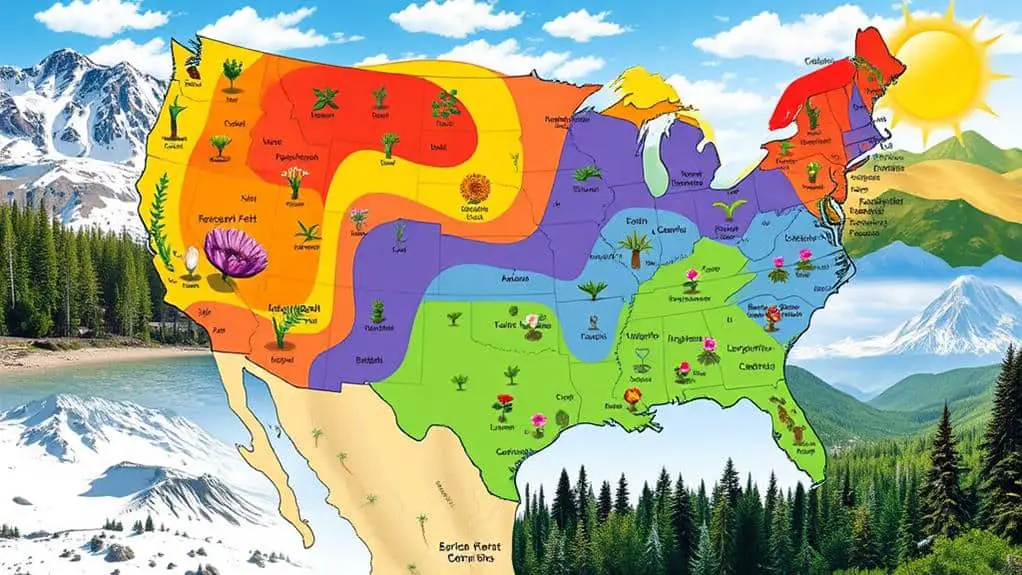
Understanding your USDA Plant Hardiness Zone is essential for successful gardening. These zones, also known as growing zones, help you know which plants will thrive in your area by considering the average annual extreme minimum winter temperatures.
Here's how you can identify your zone:
- Use the USDA Plant Hardiness Zone Map: This map divides the United States into 11 zones, each reflecting a 10-degree Fahrenheit range. Zone 1 is the coldest, while Zone 13 is the warmest.
- Zip Code Search Tool: For precise zone identification, use the quick Zip Code Search tool on the USDA website. This tool provides accurate information based on your specific location.
- Consider Local Climate Variations: Sometimes, local climate variations and microclimates can affect your gardening zone. It's important to keep these factors in mind when planning your garden.
- Interactive State Maps: Check out the interactive maps for a detailed view of your state's hardiness zones. These maps highlight specific growing conditions and plant adaptability, helping you make informed decisions.
Gardening Tips by Zone

After pinpointing your USDA Plant Hardiness Zone, you can tailor your gardening efforts to ascertain the best results. Knowing your zone helps you choose plants that will thrive in your local climate.
For example, if you live in Zone 5, you'll want plants that can handle temperatures as low as -20°F.
Start by selecting plants labeled for your zone. This ascertains they can survive your area's winter temperatures.
Also, keep an eye on frost dates. The last frost date in spring tells you when it's safe to start planting, while the first frost date in fall signals when to protect sensitive plants.
Use local climate data to fine-tune your planting schedule. Microclimates, or small areas with slightly different conditions than the general region, can affect how well certain plants grow.
Engage with regional gardening resources and community experts to learn more about your specific zone. They can offer tips and insights tailored to your area's unique conditions.
The Role of Microclimates

When you're gardening, don't overlook the importance of microclimates, those localized areas where climate conditions differ from the surrounding region. Microclimates can be influenced by factors like elevation, proximity to bodies of water, and urban development. Understanding these variations can help you make smarter plant selection choices within your USDA hardiness zone.
Here are some key points to reflect on:
- South-facing slopes: These areas can retain more heat and light, creating a warmer microclimate. This might allow you to grow plants that typically require a warmer climate than your hardiness zone suggests.
- Urban heat islands: Cities often have higher temperatures due to concrete and buildings, extending the growing season. You might be able to cultivate plants suited for warmer zones in these urban areas.
- Vegetation and structures: Trees, buildings, and other structures can block wind and retain moisture, creating unique microclimates. This can impact plant survival and growth positively or negatively, depending on the plant's needs.
- Soil types: Different soils can affect moisture levels and temperature. Sandy soils might dry out faster, while clay soils retain water longer, influencing what you can grow successfully.
Advances in ARS Research
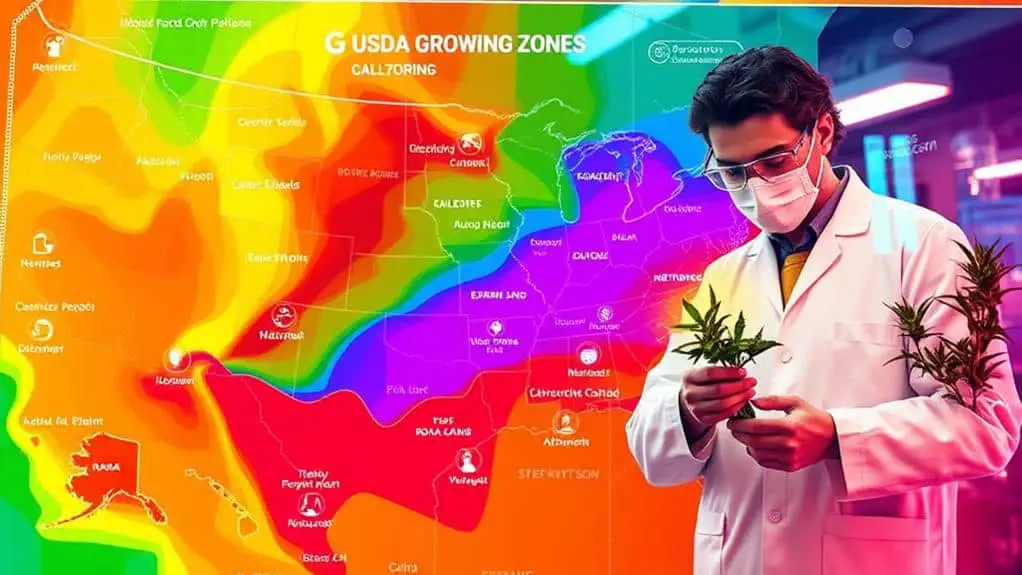
In recent years, significant strides in ARS research have revolutionized agricultural practices. ARS scientists have developed advanced carbon mapping equipment, providing precise data on soil quality. This helps you enhance crop production and sustainability in your growing zone.
One key focus of ARS research is cover crops. These plants improve soil health and reduce erosion, benefiting your garden's average annual yield. By incorporating cover crops, you're setting the stage for healthier soil and better crops year after year.
Perennial plants, like trees, are another area of interest. These plants not only contribute to timber production but also serve as livestock feed and forage. Including perennial plants in your garden supports diverse agricultural practices, ensuring long-term success.
Climate change adaptation strategies are also a major focus. ARS research helps you adjust your gardening practices to cope with shifting environmental conditions. This knowledge is essential for maintaining a thriving garden despite changing weather patterns.
Benefits of Knowing Your Zone
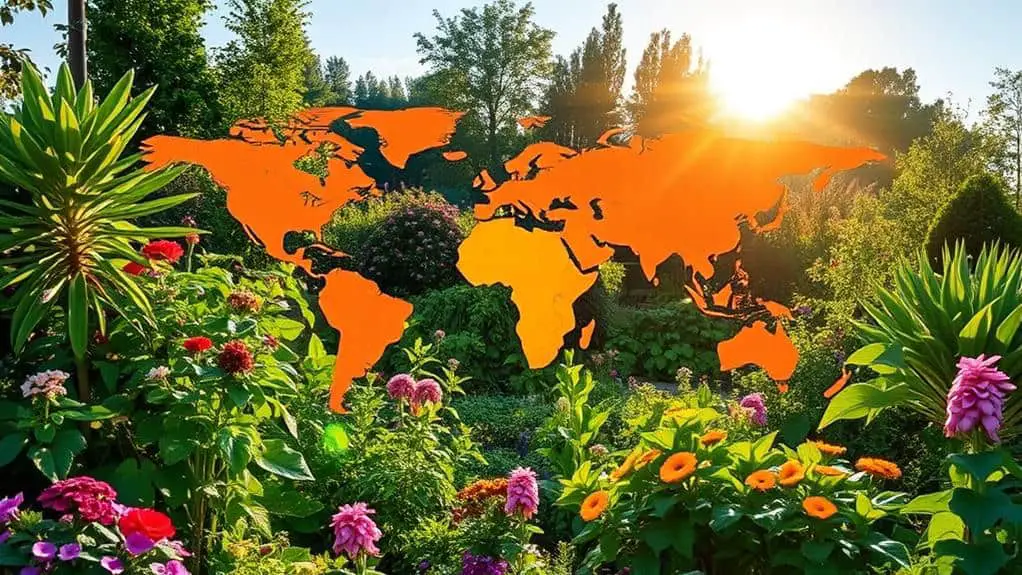
Knowing your growing zone is a game-changer for your garden.
It helps you pick plants that will thrive in your climate, giving you a better chance of gardening success.
Plus, understanding your zone means you can plan planting schedules and seasonal care routines more effectively.
Optimal Plant Selection
Understanding your growing zone is essential for selecting plants that will thrive in your local climate. Knowing your USDA hardiness zone can make a big difference in your gardening success. It helps you pick plants that can handle your area's average minimum winter temperatures. This means healthier and more resilient plants.
Here are some benefits of knowing your growing zone for ideal plant selection:
- Match Plant Hardiness: Choose plants that can survive your zone's winter temperatures. For example, if you live in Zone 6, look for plants labeled for Zones 5-9.
- Plan Your Planting Schedule: Different zones have different frost dates. Knowing your zone helps you decide when to plant seeds or move plants outdoors, avoiding frost damage.
- Select Native Species: Native plants are usually well-adapted to your local soil and climate. They often require less maintenance and are more likely to thrive.
- Seasonal Maintenance: Understanding your zone allows you to prepare for seasonal changes. You can take steps to protect your plants during extreme weather, ensuring they stay healthy year-round.
Climate Adaptation Strategies
While selecting the right plants is a vital part of successful gardening, adapting to your local climate is equally important. Knowing your growing zone helps you match plants to your local climate conditions, ensuring they thrive and live longer. By consulting the Planting Zone Map, you can pinpoint your zone and make better plant choices.
Understanding your zone also helps you plan your planting schedule. You'll know the best times to plant based on frost dates specific to your area. This means you can sow seeds or transplant seedlings at the perfect time, avoiding damage from unexpected frosts.
Recognizing your zone's unique characteristics, like temperature ranges and seasonal changes, lets you decide on the best seasonal maintenance practices for your plants. For instance, you might know when to mulch or when to water more frequently.
Familiarity with your hardiness zone can also lead you to local gardening resources. These resources provide advice tailored to your climate conditions, making your gardening efforts more effective.
Lastly, identify microclimates within your zone. Some areas in your yard may have different conditions that can benefit specific plants. By leveraging these microclimates, you can enhance plant health and yield.
Enhanced Gardening Success
Gardening becomes considerably easier and more successful when you know your growing zone. By understanding your zone, you can select plants that are well-suited to your local climate, increasing the likelihood of successful growth and survival.
The USDA Plant Hardiness Zone Map provides specific temperature ranges, helping you determine which plants can thrive during your region's winter conditions.
Here are four key benefits of knowing your growing zone:
- Plant Selection: Choose plants that are adapted to your climate, ensuring they can handle the local weather and soil conditions.
- Optimal Planting Schedule: Plan your planting around critical dates, such as the last and first frost dates, to optimize growth cycles for different plants.
- Tailored Gardening Strategies: Recognize local microclimates within your zone to better adapt your gardening techniques, giving your plants the best chance to flourish.
- Seasonal Maintenance: Perform seasonal care based on plant hardiness and regional climate variations, ensuring your plants receive appropriate care throughout the year.
Additional Resources
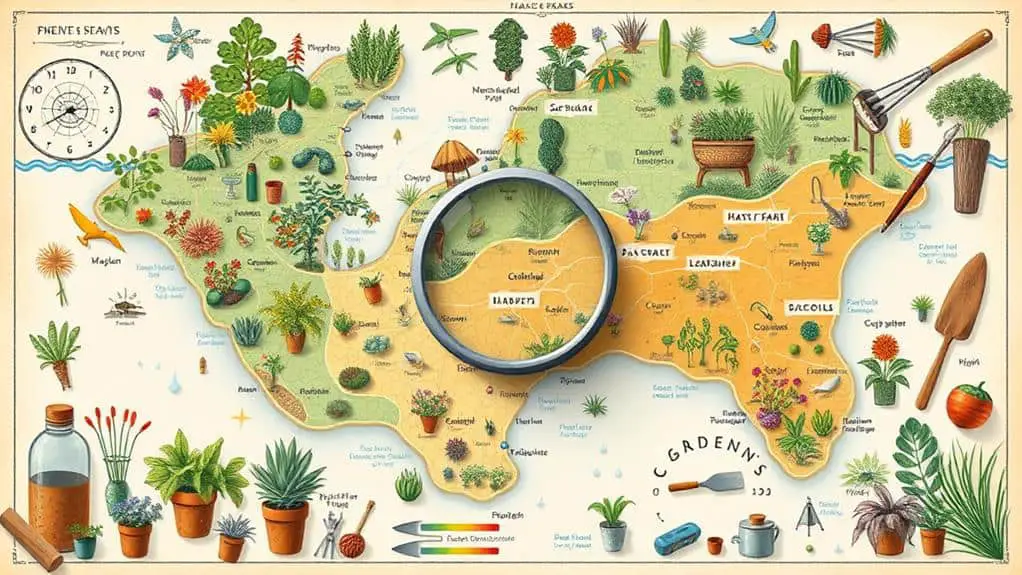
Several valuable resources can help you deepen your understanding of your specific growing zone and improve your gardening success. Start by using the USDA Plant Hardiness Zone Map, which shows zones in the United States based on winter temperatures. A quick Zip Code Search on their website will help you identify your specific zone, so you can make informed plant selection choices.
Interactive GIS-based maps are also available online. These maps offer detailed information about local climate variations and suitable perennial plants. They're a great way to get a clearer picture of your gardening environment.
Regional gardening resources and local extension services provide tailored advice for your growing zone. These resources can give you insights that are specific to your area, helping you adapt to local conditions.
Understanding local microclimates is another important aspect. Microclimates are small areas with slightly different weather patterns than the surrounding area. Recognizing these can help you choose the best spots for your plants.
Here's a quick look at some useful resources:
| Resource Type | Description |
|---|---|
| USDA Zip Code Search | Identifies your hardiness zone |
| Interactive GIS Maps | Detailed climate and plant information |
| Local Extension Services | Tailored advice for your specific growing zone |
These resources will surely boost your gardening confidence and success. Happy gardening!
Frequently Asked Questions
What Plant Zone Is Texas In?
Texas spans USDA plant zones 6a to 9b. You'll find cold-hardy plants in zones 6a and 6b, while zones 9a and 9b support heat-loving, tropical plants. Zones 7 and 8 offer a mix of both.
What Climate Zone Is Houston In?
Houston falls primarily in USDA Hardiness Zone 9a, with some areas in Zone 9b. You can grow a wide variety of heat-loving and tropical plants. The city's warm, humid subtropical climate gives you a longer growing season.
What USDA Zone Is Houston, TX In?
You're in USDA Hardiness Zones 9a and 9b if you're in Houston, TX. This means winter temperatures range from 20°F to 30°F, allowing you to grow a variety of tropical and heat-loving plants successfully.
What Zone Is Indiana In?
You're in Indiana, which is mostly in USDA Hardiness Zones 5b to 6a. Northern Indiana usually falls in Zone 5b, while central and southern parts are in Zone 6a. Always check your local zone for precise gardening.
Conclusion
You've got everything you need to start your gardening adventure! Knowing your USDA hardiness zone helps you choose the perfect plants for your area, ensuring they thrive. Don't forget to take into account microclimates and use the resources available to you. With the right information and a bit of care, your garden will flourish. So, roll up your sleeves, dig in, and watch your plants grow beautifully. You've got this! Happy gardening!

